Management Accounting Report: Costing, Budgeting, and Control
VerifiedAdded on 2020/11/23
|18
|5651
|144
Report
AI Summary
This report provides a comprehensive overview of management accounting, focusing on its role in business operations and decision-making. It begins by defining management accounting and contrasting it with financial accounting, highlighting their differences in purpose, audience, and reporting standards. The report then delves into various management accounting systems, including cost accounting, inventory accounting, and job costing systems, explaining their key requirements and applications. Furthermore, it examines different methods for managerial accounting reporting, such as budget reports and performance reports, and their significance in planning, control, and performance evaluation. The report also covers the preparation of income statements using absorption and marginal costing systems, along with a discussion of the advantages and disadvantages of budgetary control tools. Finally, it addresses how management accounting systems can be adapted to address financial problems, offering practical insights for effective financial management. This report offers valuable insights for students studying management accounting and provides a solid foundation for understanding its practical applications.
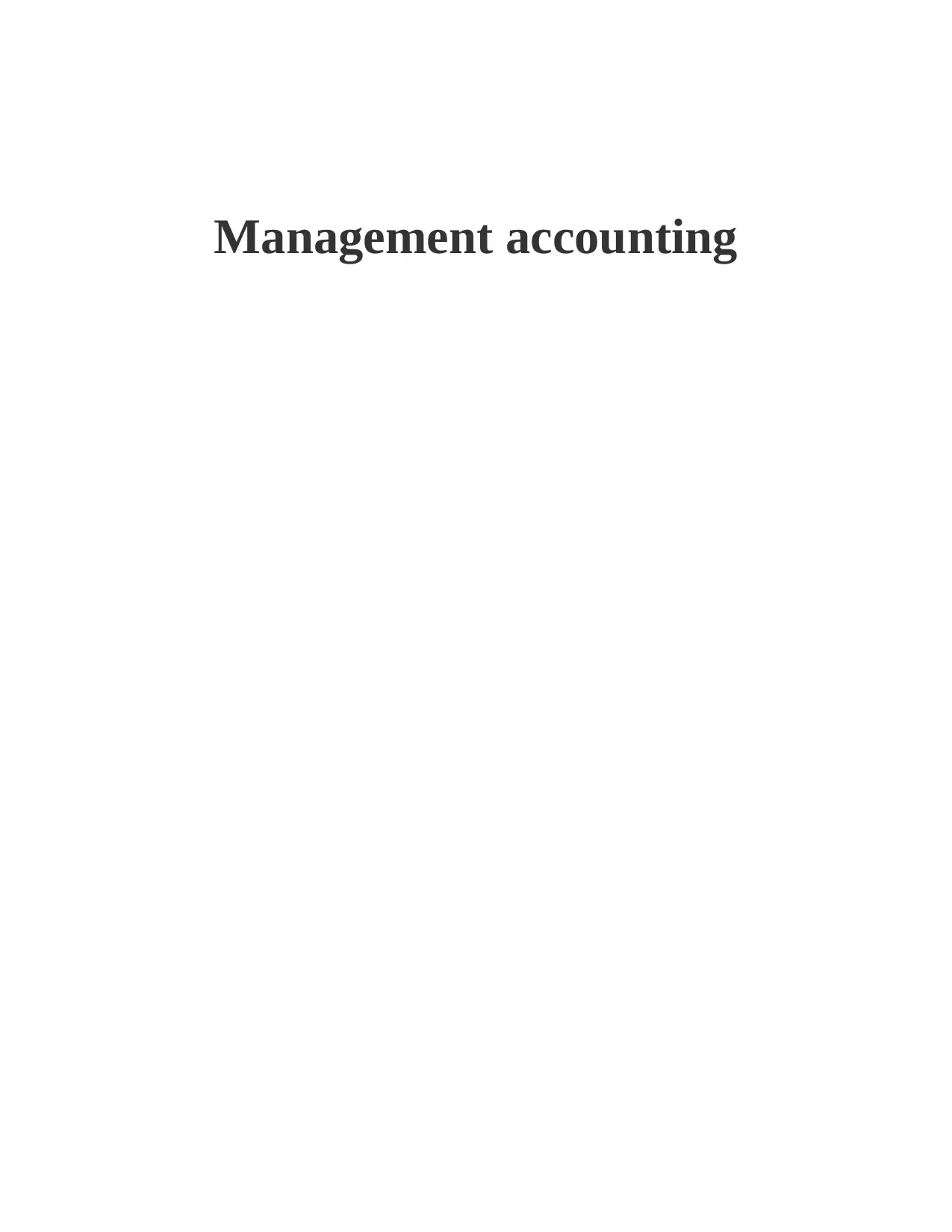
Management accounting
Paraphrase This Document
Need a fresh take? Get an instant paraphrase of this document with our AI Paraphraser
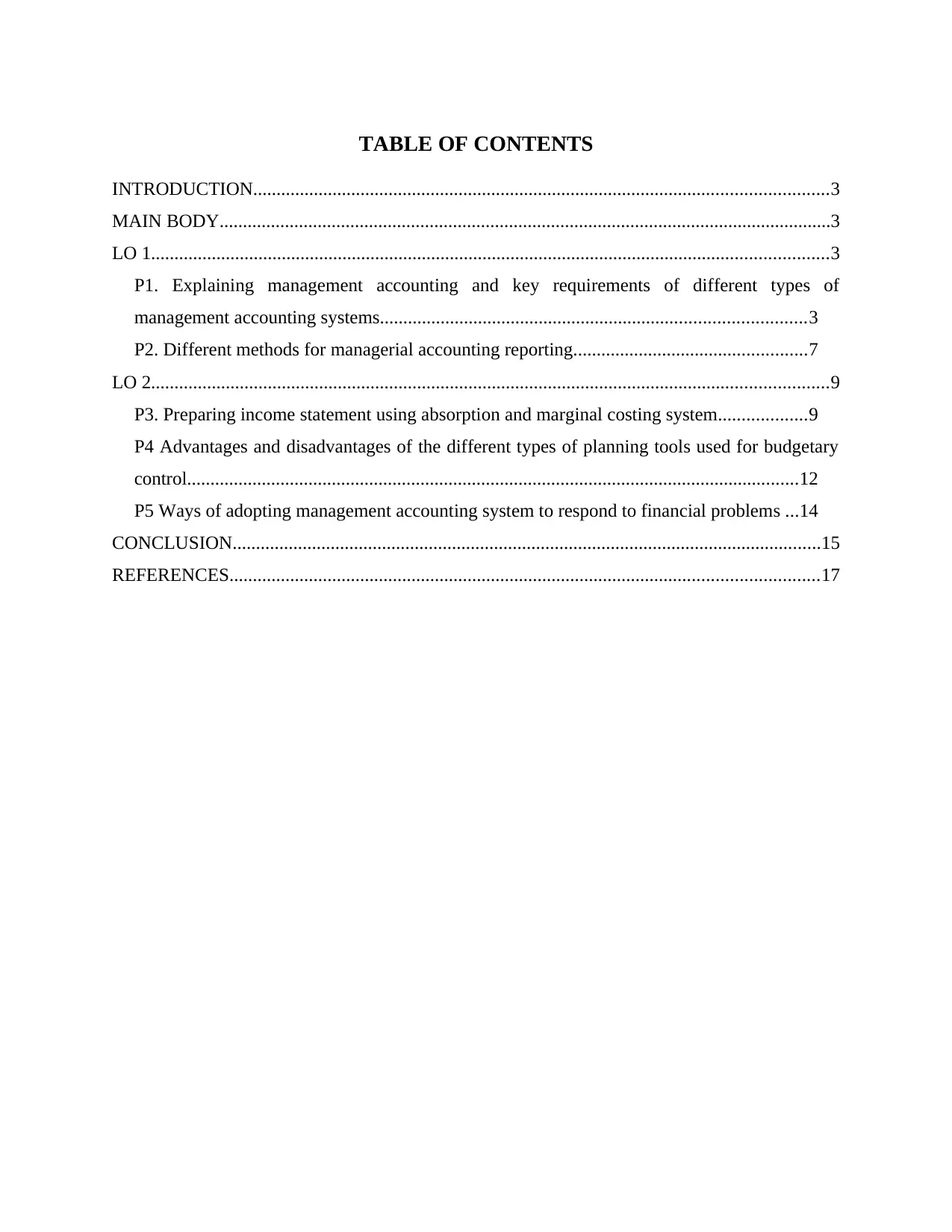
TABLE OF CONTENTS
INTRODUCTION...........................................................................................................................3
MAIN BODY...................................................................................................................................3
LO 1.................................................................................................................................................3
P1. Explaining management accounting and key requirements of different types of
management accounting systems...........................................................................................3
P2. Different methods for managerial accounting reporting..................................................7
LO 2.................................................................................................................................................9
P3. Preparing income statement using absorption and marginal costing system...................9
P4 Advantages and disadvantages of the different types of planning tools used for budgetary
control...................................................................................................................................12
P5 Ways of adopting management accounting system to respond to financial problems ...14
CONCLUSION..............................................................................................................................15
REFERENCES..............................................................................................................................17
INTRODUCTION...........................................................................................................................3
MAIN BODY...................................................................................................................................3
LO 1.................................................................................................................................................3
P1. Explaining management accounting and key requirements of different types of
management accounting systems...........................................................................................3
P2. Different methods for managerial accounting reporting..................................................7
LO 2.................................................................................................................................................9
P3. Preparing income statement using absorption and marginal costing system...................9
P4 Advantages and disadvantages of the different types of planning tools used for budgetary
control...................................................................................................................................12
P5 Ways of adopting management accounting system to respond to financial problems ...14
CONCLUSION..............................................................................................................................15
REFERENCES..............................................................................................................................17
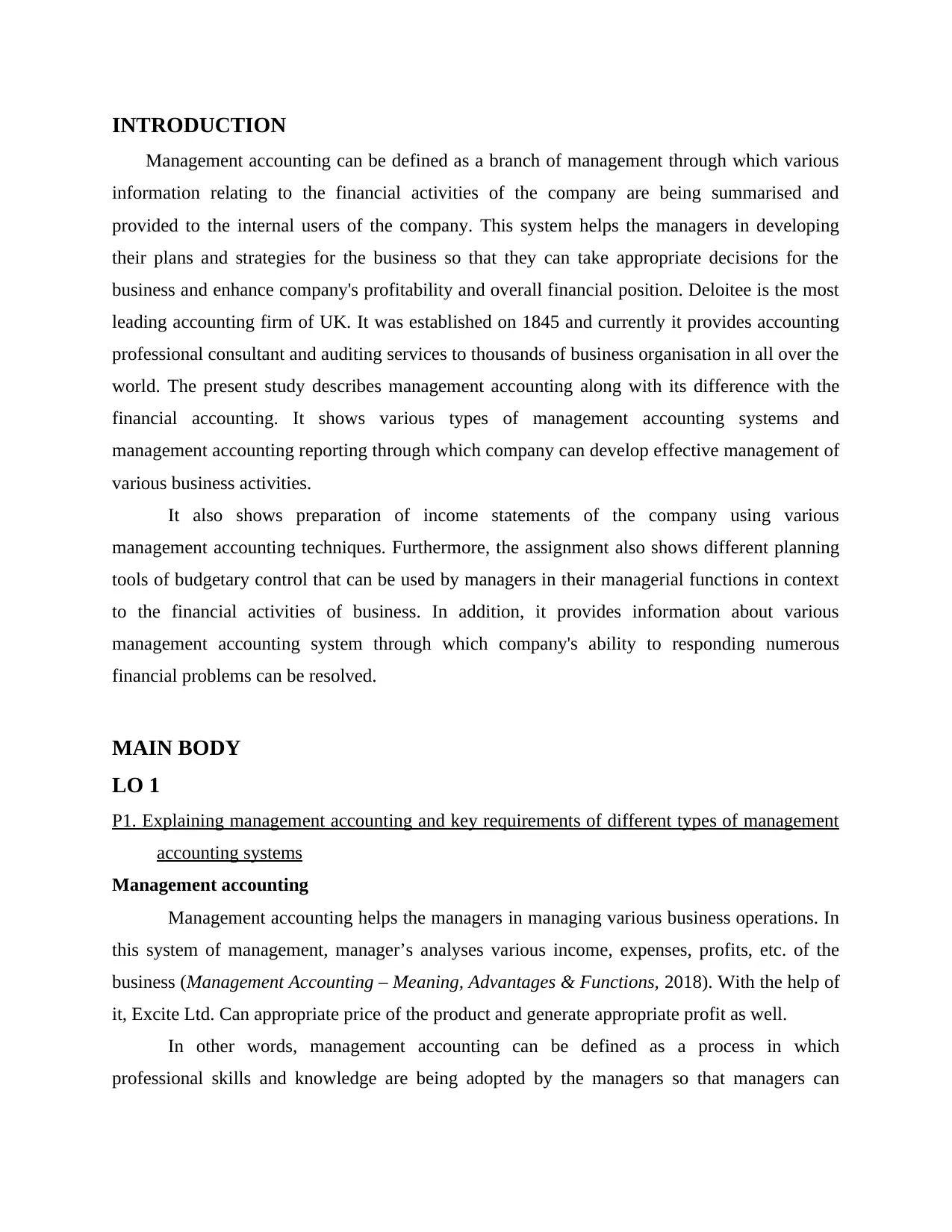
INTRODUCTION
Management accounting can be defined as a branch of management through which various
information relating to the financial activities of the company are being summarised and
provided to the internal users of the company. This system helps the managers in developing
their plans and strategies for the business so that they can take appropriate decisions for the
business and enhance company's profitability and overall financial position. Deloitee is the most
leading accounting firm of UK. It was established on 1845 and currently it provides accounting
professional consultant and auditing services to thousands of business organisation in all over the
world. The present study describes management accounting along with its difference with the
financial accounting. It shows various types of management accounting systems and
management accounting reporting through which company can develop effective management of
various business activities.
It also shows preparation of income statements of the company using various
management accounting techniques. Furthermore, the assignment also shows different planning
tools of budgetary control that can be used by managers in their managerial functions in context
to the financial activities of business. In addition, it provides information about various
management accounting system through which company's ability to responding numerous
financial problems can be resolved.
MAIN BODY
LO 1
P1. Explaining management accounting and key requirements of different types of management
accounting systems
Management accounting
Management accounting helps the managers in managing various business operations. In
this system of management, manager’s analyses various income, expenses, profits, etc. of the
business (Management Accounting – Meaning, Advantages & Functions, 2018). With the help of
it, Excite Ltd. Can appropriate price of the product and generate appropriate profit as well.
In other words, management accounting can be defined as a process in which
professional skills and knowledge are being adopted by the managers so that managers can
Management accounting can be defined as a branch of management through which various
information relating to the financial activities of the company are being summarised and
provided to the internal users of the company. This system helps the managers in developing
their plans and strategies for the business so that they can take appropriate decisions for the
business and enhance company's profitability and overall financial position. Deloitee is the most
leading accounting firm of UK. It was established on 1845 and currently it provides accounting
professional consultant and auditing services to thousands of business organisation in all over the
world. The present study describes management accounting along with its difference with the
financial accounting. It shows various types of management accounting systems and
management accounting reporting through which company can develop effective management of
various business activities.
It also shows preparation of income statements of the company using various
management accounting techniques. Furthermore, the assignment also shows different planning
tools of budgetary control that can be used by managers in their managerial functions in context
to the financial activities of business. In addition, it provides information about various
management accounting system through which company's ability to responding numerous
financial problems can be resolved.
MAIN BODY
LO 1
P1. Explaining management accounting and key requirements of different types of management
accounting systems
Management accounting
Management accounting helps the managers in managing various business operations. In
this system of management, manager’s analyses various income, expenses, profits, etc. of the
business (Management Accounting – Meaning, Advantages & Functions, 2018). With the help of
it, Excite Ltd. Can appropriate price of the product and generate appropriate profit as well.
In other words, management accounting can be defined as a process in which
professional skills and knowledge are being adopted by the managers so that managers can
⊘ This is a preview!⊘
Do you want full access?
Subscribe today to unlock all pages.

Trusted by 1+ million students worldwide
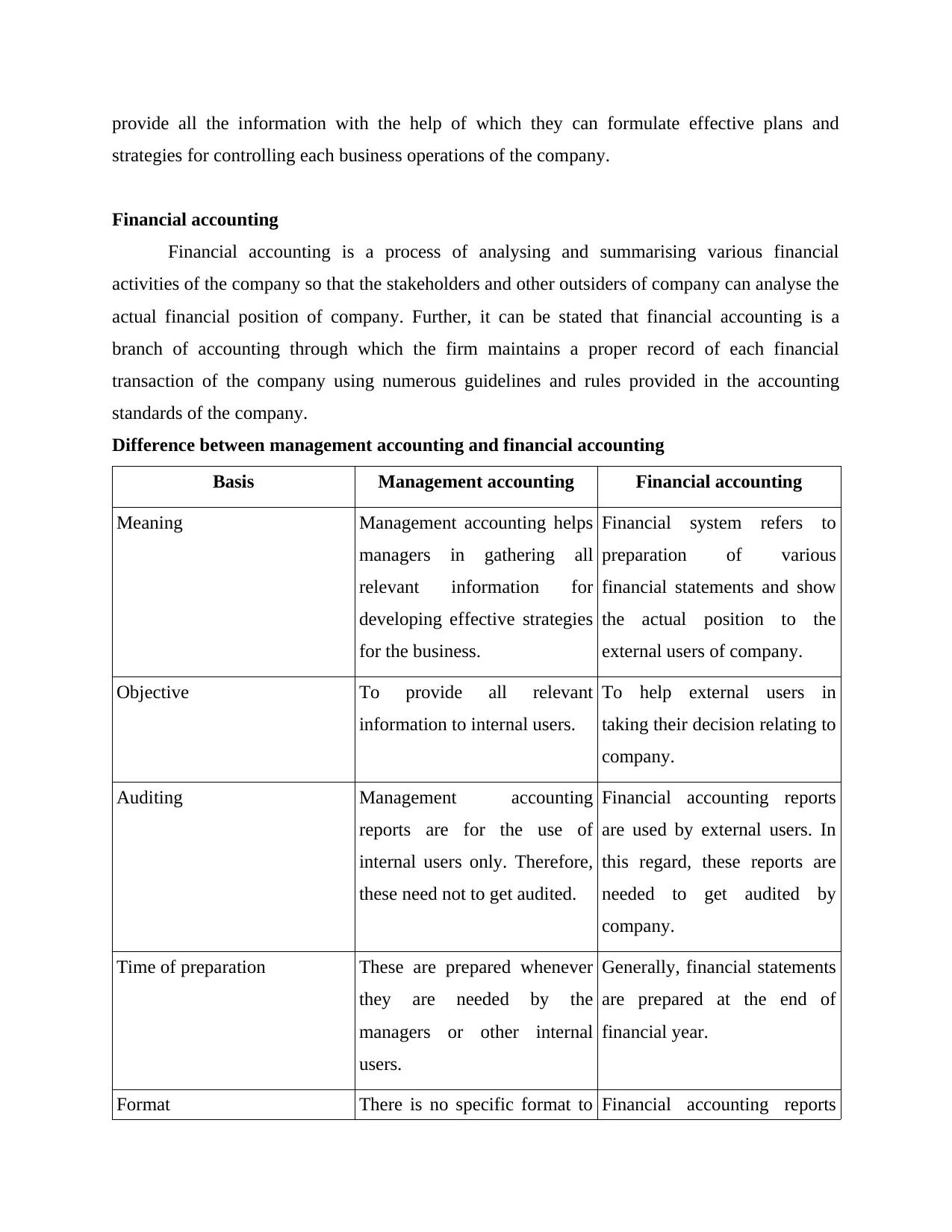
provide all the information with the help of which they can formulate effective plans and
strategies for controlling each business operations of the company.
Financial accounting
Financial accounting is a process of analysing and summarising various financial
activities of the company so that the stakeholders and other outsiders of company can analyse the
actual financial position of company. Further, it can be stated that financial accounting is a
branch of accounting through which the firm maintains a proper record of each financial
transaction of the company using numerous guidelines and rules provided in the accounting
standards of the company.
Difference between management accounting and financial accounting
Basis Management accounting Financial accounting
Meaning Management accounting helps
managers in gathering all
relevant information for
developing effective strategies
for the business.
Financial system refers to
preparation of various
financial statements and show
the actual position to the
external users of company.
Objective To provide all relevant
information to internal users.
To help external users in
taking their decision relating to
company.
Auditing Management accounting
reports are for the use of
internal users only. Therefore,
these need not to get audited.
Financial accounting reports
are used by external users. In
this regard, these reports are
needed to get audited by
company.
Time of preparation These are prepared whenever
they are needed by the
managers or other internal
users.
Generally, financial statements
are prepared at the end of
financial year.
Format There is no specific format to Financial accounting reports
strategies for controlling each business operations of the company.
Financial accounting
Financial accounting is a process of analysing and summarising various financial
activities of the company so that the stakeholders and other outsiders of company can analyse the
actual financial position of company. Further, it can be stated that financial accounting is a
branch of accounting through which the firm maintains a proper record of each financial
transaction of the company using numerous guidelines and rules provided in the accounting
standards of the company.
Difference between management accounting and financial accounting
Basis Management accounting Financial accounting
Meaning Management accounting helps
managers in gathering all
relevant information for
developing effective strategies
for the business.
Financial system refers to
preparation of various
financial statements and show
the actual position to the
external users of company.
Objective To provide all relevant
information to internal users.
To help external users in
taking their decision relating to
company.
Auditing Management accounting
reports are for the use of
internal users only. Therefore,
these need not to get audited.
Financial accounting reports
are used by external users. In
this regard, these reports are
needed to get audited by
company.
Time of preparation These are prepared whenever
they are needed by the
managers or other internal
users.
Generally, financial statements
are prepared at the end of
financial year.
Format There is no specific format to Financial accounting reports
Paraphrase This Document
Need a fresh take? Get an instant paraphrase of this document with our AI Paraphraser
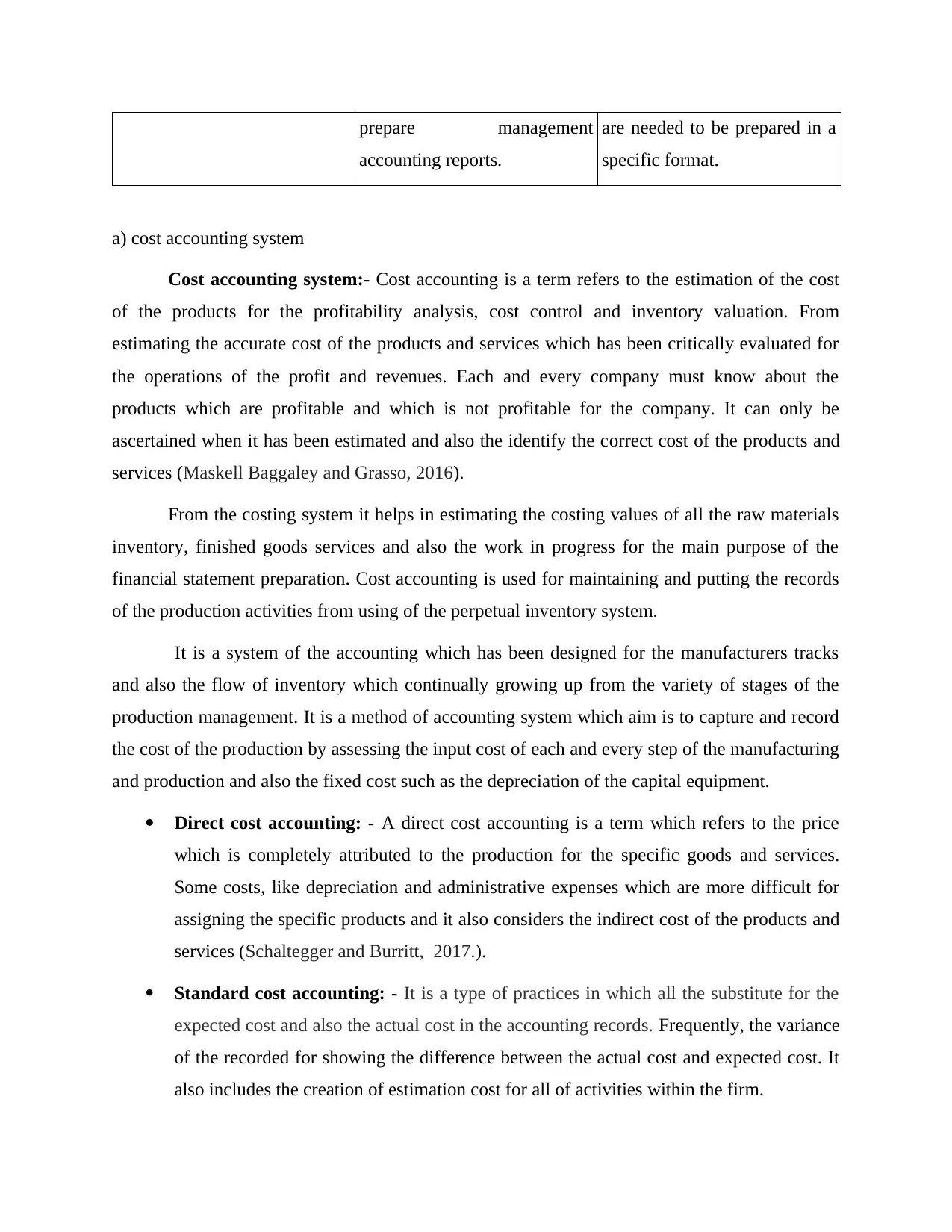
prepare management
accounting reports.
are needed to be prepared in a
specific format.
a) cost accounting system
Cost accounting system:- Cost accounting is a term refers to the estimation of the cost
of the products for the profitability analysis, cost control and inventory valuation. From
estimating the accurate cost of the products and services which has been critically evaluated for
the operations of the profit and revenues. Each and every company must know about the
products which are profitable and which is not profitable for the company. It can only be
ascertained when it has been estimated and also the identify the correct cost of the products and
services (Maskell Baggaley and Grasso, 2016).
From the costing system it helps in estimating the costing values of all the raw materials
inventory, finished goods services and also the work in progress for the main purpose of the
financial statement preparation. Cost accounting is used for maintaining and putting the records
of the production activities from using of the perpetual inventory system.
It is a system of the accounting which has been designed for the manufacturers tracks
and also the flow of inventory which continually growing up from the variety of stages of the
production management. It is a method of accounting system which aim is to capture and record
the cost of the production by assessing the input cost of each and every step of the manufacturing
and production and also the fixed cost such as the depreciation of the capital equipment.
Direct cost accounting: - A direct cost accounting is a term which refers to the price
which is completely attributed to the production for the specific goods and services.
Some costs, like depreciation and administrative expenses which are more difficult for
assigning the specific products and it also considers the indirect cost of the products and
services (Schaltegger and Burritt, 2017.).
Standard cost accounting: - It is a type of practices in which all the substitute for the
expected cost and also the actual cost in the accounting records. Frequently, the variance
of the recorded for showing the difference between the actual cost and expected cost. It
also includes the creation of estimation cost for all of activities within the firm.
accounting reports.
are needed to be prepared in a
specific format.
a) cost accounting system
Cost accounting system:- Cost accounting is a term refers to the estimation of the cost
of the products for the profitability analysis, cost control and inventory valuation. From
estimating the accurate cost of the products and services which has been critically evaluated for
the operations of the profit and revenues. Each and every company must know about the
products which are profitable and which is not profitable for the company. It can only be
ascertained when it has been estimated and also the identify the correct cost of the products and
services (Maskell Baggaley and Grasso, 2016).
From the costing system it helps in estimating the costing values of all the raw materials
inventory, finished goods services and also the work in progress for the main purpose of the
financial statement preparation. Cost accounting is used for maintaining and putting the records
of the production activities from using of the perpetual inventory system.
It is a system of the accounting which has been designed for the manufacturers tracks
and also the flow of inventory which continually growing up from the variety of stages of the
production management. It is a method of accounting system which aim is to capture and record
the cost of the production by assessing the input cost of each and every step of the manufacturing
and production and also the fixed cost such as the depreciation of the capital equipment.
Direct cost accounting: - A direct cost accounting is a term which refers to the price
which is completely attributed to the production for the specific goods and services.
Some costs, like depreciation and administrative expenses which are more difficult for
assigning the specific products and it also considers the indirect cost of the products and
services (Schaltegger and Burritt, 2017.).
Standard cost accounting: - It is a type of practices in which all the substitute for the
expected cost and also the actual cost in the accounting records. Frequently, the variance
of the recorded for showing the difference between the actual cost and expected cost. It
also includes the creation of estimation cost for all of activities within the firm.
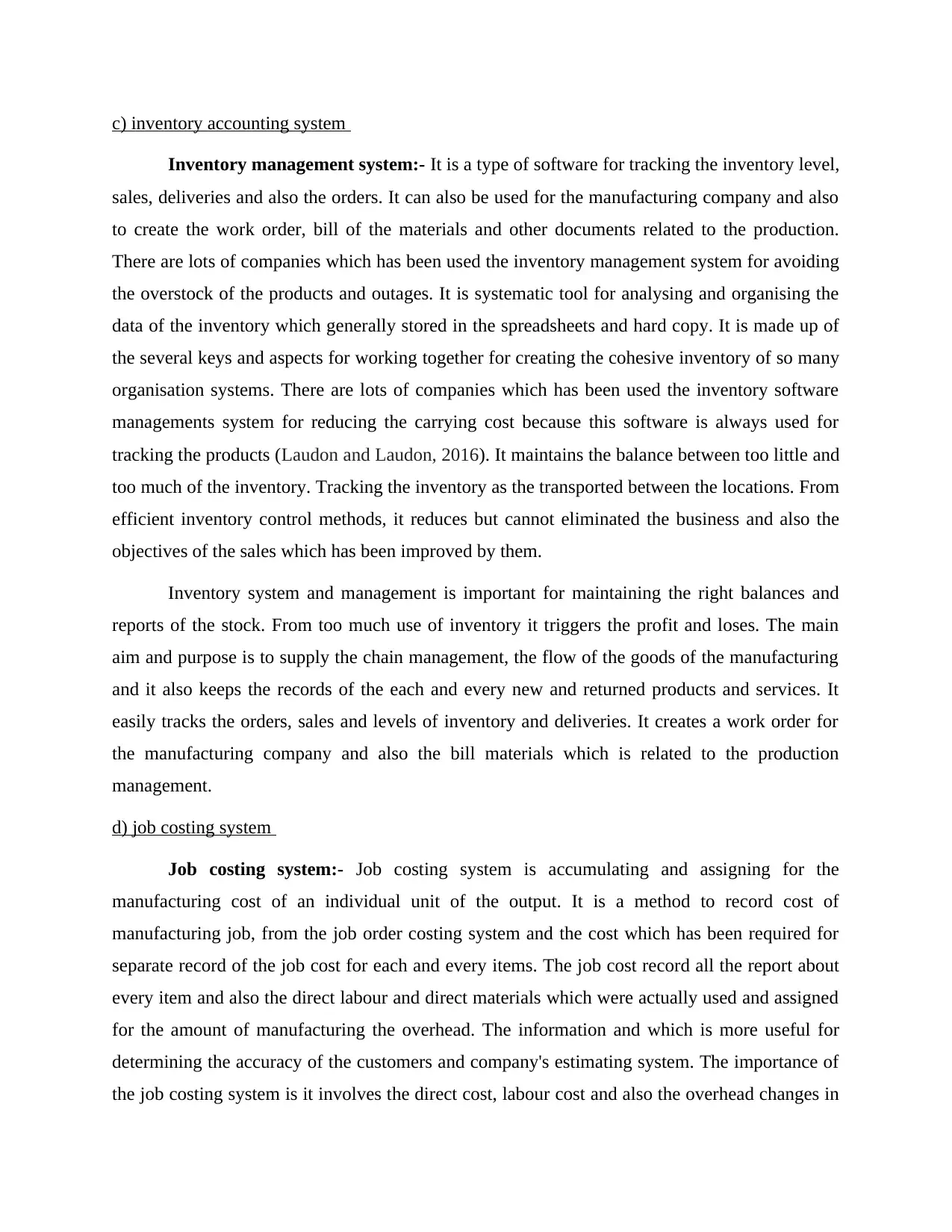
c) inventory accounting system
Inventory management system:- It is a type of software for tracking the inventory level,
sales, deliveries and also the orders. It can also be used for the manufacturing company and also
to create the work order, bill of the materials and other documents related to the production.
There are lots of companies which has been used the inventory management system for avoiding
the overstock of the products and outages. It is systematic tool for analysing and organising the
data of the inventory which generally stored in the spreadsheets and hard copy. It is made up of
the several keys and aspects for working together for creating the cohesive inventory of so many
organisation systems. There are lots of companies which has been used the inventory software
managements system for reducing the carrying cost because this software is always used for
tracking the products (Laudon and Laudon, 2016). It maintains the balance between too little and
too much of the inventory. Tracking the inventory as the transported between the locations. From
efficient inventory control methods, it reduces but cannot eliminated the business and also the
objectives of the sales which has been improved by them.
Inventory system and management is important for maintaining the right balances and
reports of the stock. From too much use of inventory it triggers the profit and loses. The main
aim and purpose is to supply the chain management, the flow of the goods of the manufacturing
and it also keeps the records of the each and every new and returned products and services. It
easily tracks the orders, sales and levels of inventory and deliveries. It creates a work order for
the manufacturing company and also the bill materials which is related to the production
management.
d) job costing system
Job costing system:- Job costing system is accumulating and assigning for the
manufacturing cost of an individual unit of the output. It is a method to record cost of
manufacturing job, from the job order costing system and the cost which has been required for
separate record of the job cost for each and every items. The job cost record all the report about
every item and also the direct labour and direct materials which were actually used and assigned
for the amount of manufacturing the overhead. The information and which is more useful for
determining the accuracy of the customers and company's estimating system. The importance of
the job costing system is it involves the direct cost, labour cost and also the overhead changes in
Inventory management system:- It is a type of software for tracking the inventory level,
sales, deliveries and also the orders. It can also be used for the manufacturing company and also
to create the work order, bill of the materials and other documents related to the production.
There are lots of companies which has been used the inventory management system for avoiding
the overstock of the products and outages. It is systematic tool for analysing and organising the
data of the inventory which generally stored in the spreadsheets and hard copy. It is made up of
the several keys and aspects for working together for creating the cohesive inventory of so many
organisation systems. There are lots of companies which has been used the inventory software
managements system for reducing the carrying cost because this software is always used for
tracking the products (Laudon and Laudon, 2016). It maintains the balance between too little and
too much of the inventory. Tracking the inventory as the transported between the locations. From
efficient inventory control methods, it reduces but cannot eliminated the business and also the
objectives of the sales which has been improved by them.
Inventory system and management is important for maintaining the right balances and
reports of the stock. From too much use of inventory it triggers the profit and loses. The main
aim and purpose is to supply the chain management, the flow of the goods of the manufacturing
and it also keeps the records of the each and every new and returned products and services. It
easily tracks the orders, sales and levels of inventory and deliveries. It creates a work order for
the manufacturing company and also the bill materials which is related to the production
management.
d) job costing system
Job costing system:- Job costing system is accumulating and assigning for the
manufacturing cost of an individual unit of the output. It is a method to record cost of
manufacturing job, from the job order costing system and the cost which has been required for
separate record of the job cost for each and every items. The job cost record all the report about
every item and also the direct labour and direct materials which were actually used and assigned
for the amount of manufacturing the overhead. The information and which is more useful for
determining the accuracy of the customers and company's estimating system. The importance of
the job costing system is it involves the direct cost, labour cost and also the overhead changes in
⊘ This is a preview!⊘
Do you want full access?
Subscribe today to unlock all pages.

Trusted by 1+ million students worldwide
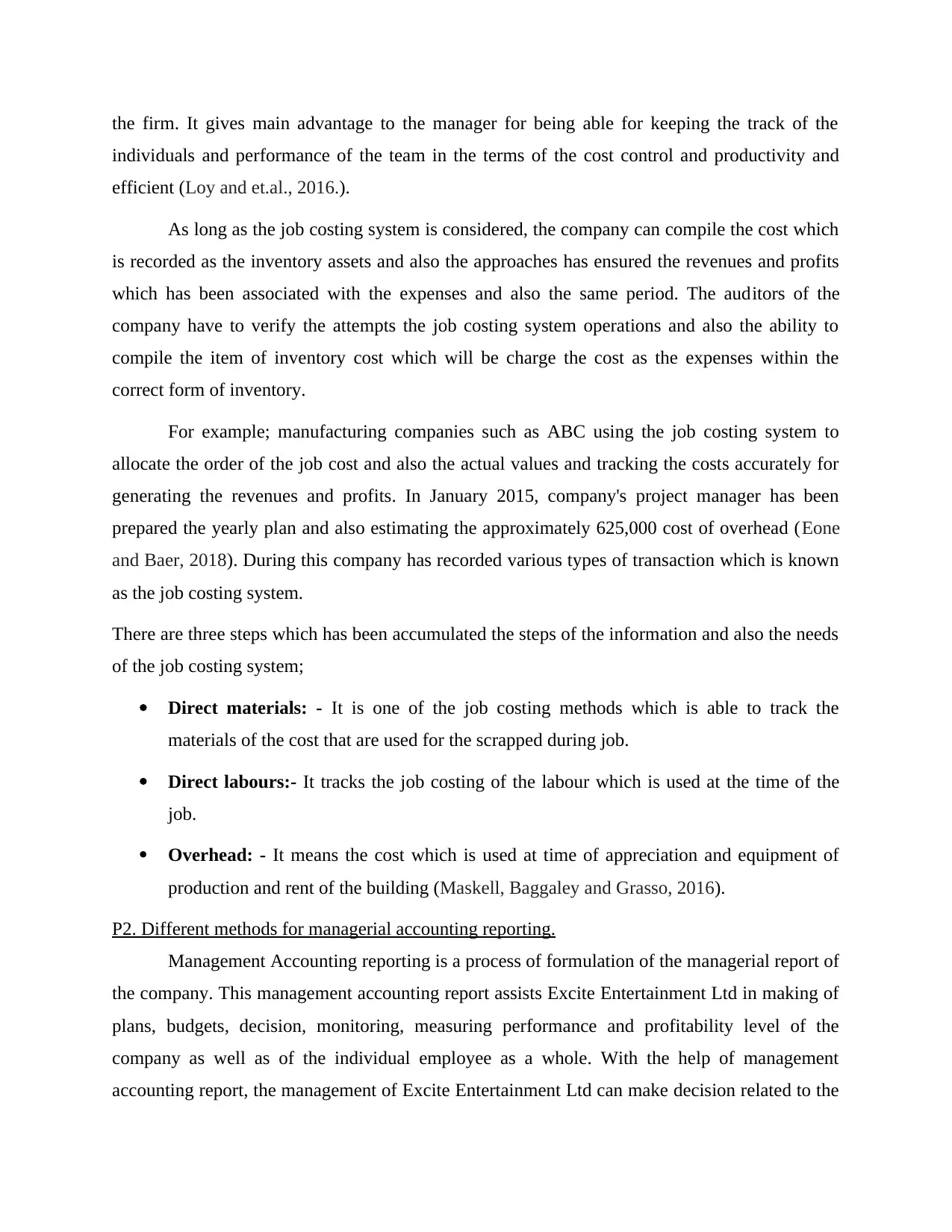
the firm. It gives main advantage to the manager for being able for keeping the track of the
individuals and performance of the team in the terms of the cost control and productivity and
efficient (Loy and et.al., 2016.).
As long as the job costing system is considered, the company can compile the cost which
is recorded as the inventory assets and also the approaches has ensured the revenues and profits
which has been associated with the expenses and also the same period. The auditors of the
company have to verify the attempts the job costing system operations and also the ability to
compile the item of inventory cost which will be charge the cost as the expenses within the
correct form of inventory.
For example; manufacturing companies such as ABC using the job costing system to
allocate the order of the job cost and also the actual values and tracking the costs accurately for
generating the revenues and profits. In January 2015, company's project manager has been
prepared the yearly plan and also estimating the approximately 625,000 cost of overhead (Eone
and Baer, 2018). During this company has recorded various types of transaction which is known
as the job costing system.
There are three steps which has been accumulated the steps of the information and also the needs
of the job costing system;
Direct materials: - It is one of the job costing methods which is able to track the
materials of the cost that are used for the scrapped during job.
Direct labours:- It tracks the job costing of the labour which is used at the time of the
job.
Overhead: - It means the cost which is used at time of appreciation and equipment of
production and rent of the building (Maskell, Baggaley and Grasso, 2016).
P2. Different methods for managerial accounting reporting.
Management Accounting reporting is a process of formulation of the managerial report of
the company. This management accounting report assists Excite Entertainment Ltd in making of
plans, budgets, decision, monitoring, measuring performance and profitability level of the
company as well as of the individual employee as a whole. With the help of management
accounting report, the management of Excite Entertainment Ltd can make decision related to the
individuals and performance of the team in the terms of the cost control and productivity and
efficient (Loy and et.al., 2016.).
As long as the job costing system is considered, the company can compile the cost which
is recorded as the inventory assets and also the approaches has ensured the revenues and profits
which has been associated with the expenses and also the same period. The auditors of the
company have to verify the attempts the job costing system operations and also the ability to
compile the item of inventory cost which will be charge the cost as the expenses within the
correct form of inventory.
For example; manufacturing companies such as ABC using the job costing system to
allocate the order of the job cost and also the actual values and tracking the costs accurately for
generating the revenues and profits. In January 2015, company's project manager has been
prepared the yearly plan and also estimating the approximately 625,000 cost of overhead (Eone
and Baer, 2018). During this company has recorded various types of transaction which is known
as the job costing system.
There are three steps which has been accumulated the steps of the information and also the needs
of the job costing system;
Direct materials: - It is one of the job costing methods which is able to track the
materials of the cost that are used for the scrapped during job.
Direct labours:- It tracks the job costing of the labour which is used at the time of the
job.
Overhead: - It means the cost which is used at time of appreciation and equipment of
production and rent of the building (Maskell, Baggaley and Grasso, 2016).
P2. Different methods for managerial accounting reporting.
Management Accounting reporting is a process of formulation of the managerial report of
the company. This management accounting report assists Excite Entertainment Ltd in making of
plans, budgets, decision, monitoring, measuring performance and profitability level of the
company as well as of the individual employee as a whole. With the help of management
accounting report, the management of Excite Entertainment Ltd can make decision related to the
Paraphrase This Document
Need a fresh take? Get an instant paraphrase of this document with our AI Paraphraser
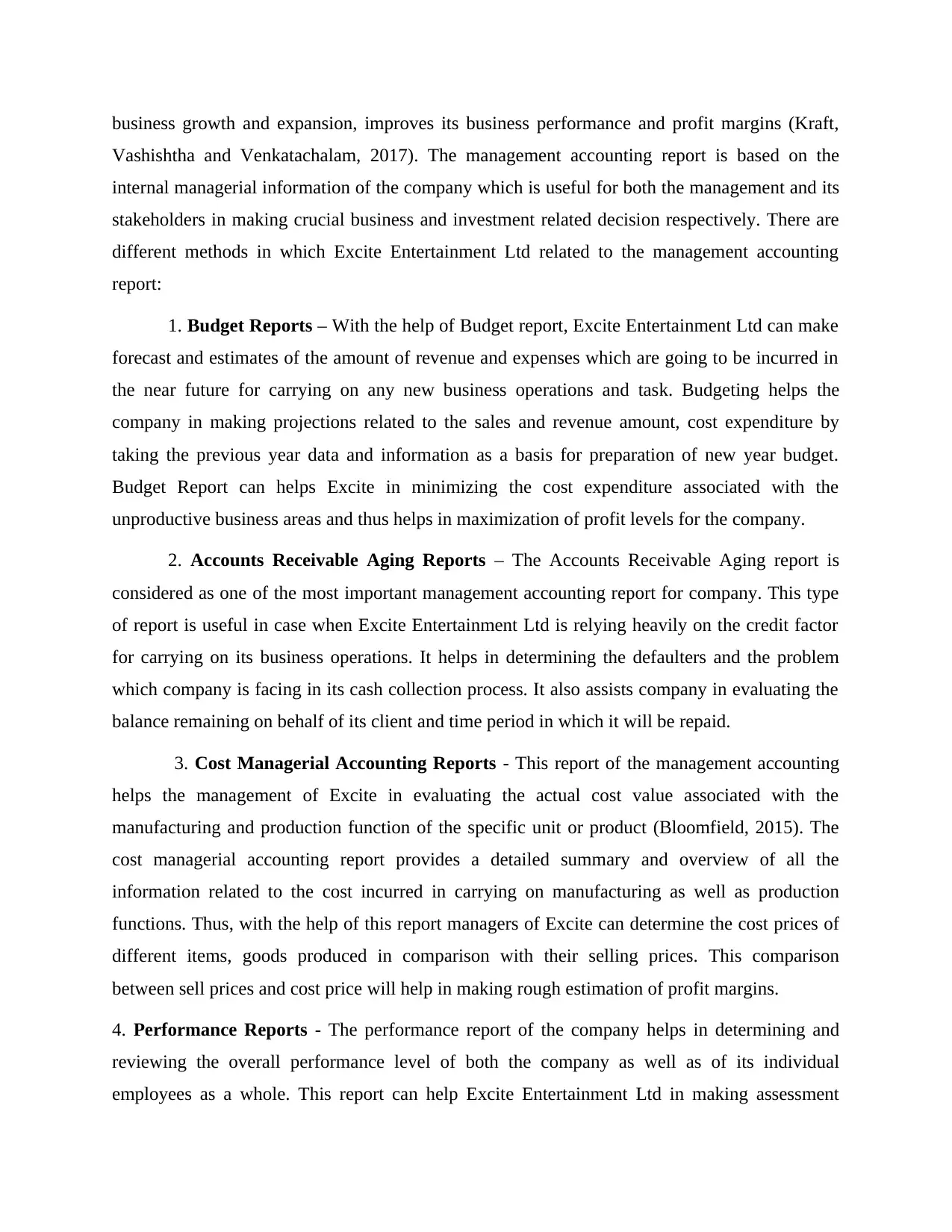
business growth and expansion, improves its business performance and profit margins (Kraft,
Vashishtha and Venkatachalam, 2017). The management accounting report is based on the
internal managerial information of the company which is useful for both the management and its
stakeholders in making crucial business and investment related decision respectively. There are
different methods in which Excite Entertainment Ltd related to the management accounting
report:
1. Budget Reports – With the help of Budget report, Excite Entertainment Ltd can make
forecast and estimates of the amount of revenue and expenses which are going to be incurred in
the near future for carrying on any new business operations and task. Budgeting helps the
company in making projections related to the sales and revenue amount, cost expenditure by
taking the previous year data and information as a basis for preparation of new year budget.
Budget Report can helps Excite in minimizing the cost expenditure associated with the
unproductive business areas and thus helps in maximization of profit levels for the company.
2. Accounts Receivable Aging Reports – The Accounts Receivable Aging report is
considered as one of the most important management accounting report for company. This type
of report is useful in case when Excite Entertainment Ltd is relying heavily on the credit factor
for carrying on its business operations. It helps in determining the defaulters and the problem
which company is facing in its cash collection process. It also assists company in evaluating the
balance remaining on behalf of its client and time period in which it will be repaid.
3. Cost Managerial Accounting Reports - This report of the management accounting
helps the management of Excite in evaluating the actual cost value associated with the
manufacturing and production function of the specific unit or product (Bloomfield, 2015). The
cost managerial accounting report provides a detailed summary and overview of all the
information related to the cost incurred in carrying on manufacturing as well as production
functions. Thus, with the help of this report managers of Excite can determine the cost prices of
different items, goods produced in comparison with their selling prices. This comparison
between sell prices and cost price will help in making rough estimation of profit margins.
4. Performance Reports - The performance report of the company helps in determining and
reviewing the overall performance level of both the company as well as of its individual
employees as a whole. This report can help Excite Entertainment Ltd in making assessment
Vashishtha and Venkatachalam, 2017). The management accounting report is based on the
internal managerial information of the company which is useful for both the management and its
stakeholders in making crucial business and investment related decision respectively. There are
different methods in which Excite Entertainment Ltd related to the management accounting
report:
1. Budget Reports – With the help of Budget report, Excite Entertainment Ltd can make
forecast and estimates of the amount of revenue and expenses which are going to be incurred in
the near future for carrying on any new business operations and task. Budgeting helps the
company in making projections related to the sales and revenue amount, cost expenditure by
taking the previous year data and information as a basis for preparation of new year budget.
Budget Report can helps Excite in minimizing the cost expenditure associated with the
unproductive business areas and thus helps in maximization of profit levels for the company.
2. Accounts Receivable Aging Reports – The Accounts Receivable Aging report is
considered as one of the most important management accounting report for company. This type
of report is useful in case when Excite Entertainment Ltd is relying heavily on the credit factor
for carrying on its business operations. It helps in determining the defaulters and the problem
which company is facing in its cash collection process. It also assists company in evaluating the
balance remaining on behalf of its client and time period in which it will be repaid.
3. Cost Managerial Accounting Reports - This report of the management accounting
helps the management of Excite in evaluating the actual cost value associated with the
manufacturing and production function of the specific unit or product (Bloomfield, 2015). The
cost managerial accounting report provides a detailed summary and overview of all the
information related to the cost incurred in carrying on manufacturing as well as production
functions. Thus, with the help of this report managers of Excite can determine the cost prices of
different items, goods produced in comparison with their selling prices. This comparison
between sell prices and cost price will help in making rough estimation of profit margins.
4. Performance Reports - The performance report of the company helps in determining and
reviewing the overall performance level of both the company as well as of its individual
employees as a whole. This report can help Excite Entertainment Ltd in making assessment
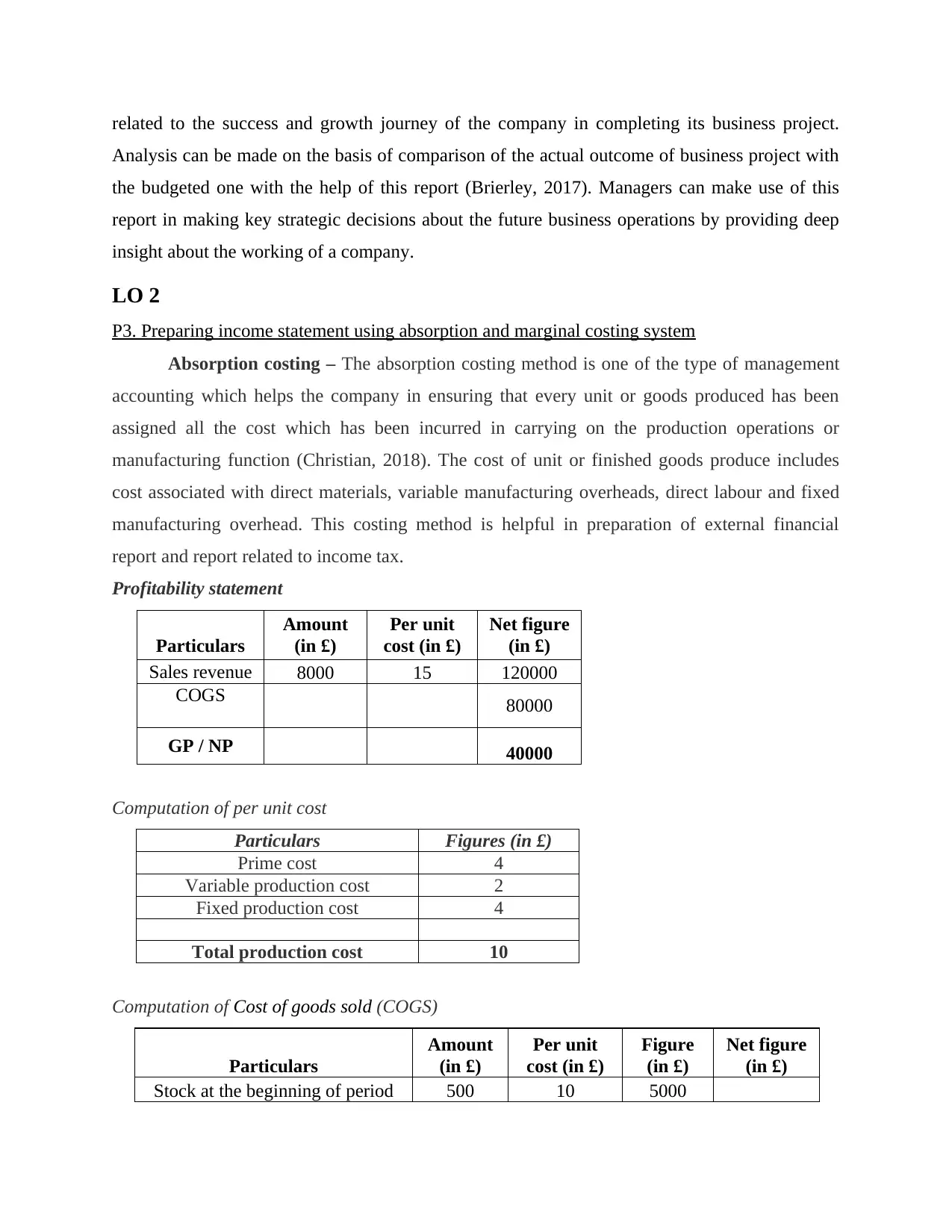
related to the success and growth journey of the company in completing its business project.
Analysis can be made on the basis of comparison of the actual outcome of business project with
the budgeted one with the help of this report (Brierley, 2017). Managers can make use of this
report in making key strategic decisions about the future business operations by providing deep
insight about the working of a company.
LO 2
P3. Preparing income statement using absorption and marginal costing system
Absorption costing – The absorption costing method is one of the type of management
accounting which helps the company in ensuring that every unit or goods produced has been
assigned all the cost which has been incurred in carrying on the production operations or
manufacturing function (Christian, 2018). The cost of unit or finished goods produce includes
cost associated with direct materials, variable manufacturing overheads, direct labour and fixed
manufacturing overhead. This costing method is helpful in preparation of external financial
report and report related to income tax.
Profitability statement
Particulars
Amount
(in £)
Per unit
cost (in £)
Net figure
(in £)
Sales revenue 8000 15 120000
COGS 80000
GP / NP 40000
Computation of per unit cost
Particulars Figures (in £)
Prime cost 4
Variable production cost 2
Fixed production cost 4
Total production cost 10
Computation of Cost of goods sold (COGS)
Particulars
Amount
(in £)
Per unit
cost (in £)
Figure
(in £)
Net figure
(in £)
Stock at the beginning of period 500 10 5000
Analysis can be made on the basis of comparison of the actual outcome of business project with
the budgeted one with the help of this report (Brierley, 2017). Managers can make use of this
report in making key strategic decisions about the future business operations by providing deep
insight about the working of a company.
LO 2
P3. Preparing income statement using absorption and marginal costing system
Absorption costing – The absorption costing method is one of the type of management
accounting which helps the company in ensuring that every unit or goods produced has been
assigned all the cost which has been incurred in carrying on the production operations or
manufacturing function (Christian, 2018). The cost of unit or finished goods produce includes
cost associated with direct materials, variable manufacturing overheads, direct labour and fixed
manufacturing overhead. This costing method is helpful in preparation of external financial
report and report related to income tax.
Profitability statement
Particulars
Amount
(in £)
Per unit
cost (in £)
Net figure
(in £)
Sales revenue 8000 15 120000
COGS 80000
GP / NP 40000
Computation of per unit cost
Particulars Figures (in £)
Prime cost 4
Variable production cost 2
Fixed production cost 4
Total production cost 10
Computation of Cost of goods sold (COGS)
Particulars
Amount
(in £)
Per unit
cost (in £)
Figure
(in £)
Net figure
(in £)
Stock at the beginning of period 500 10 5000
⊘ This is a preview!⊘
Do you want full access?
Subscribe today to unlock all pages.

Trusted by 1+ million students worldwide
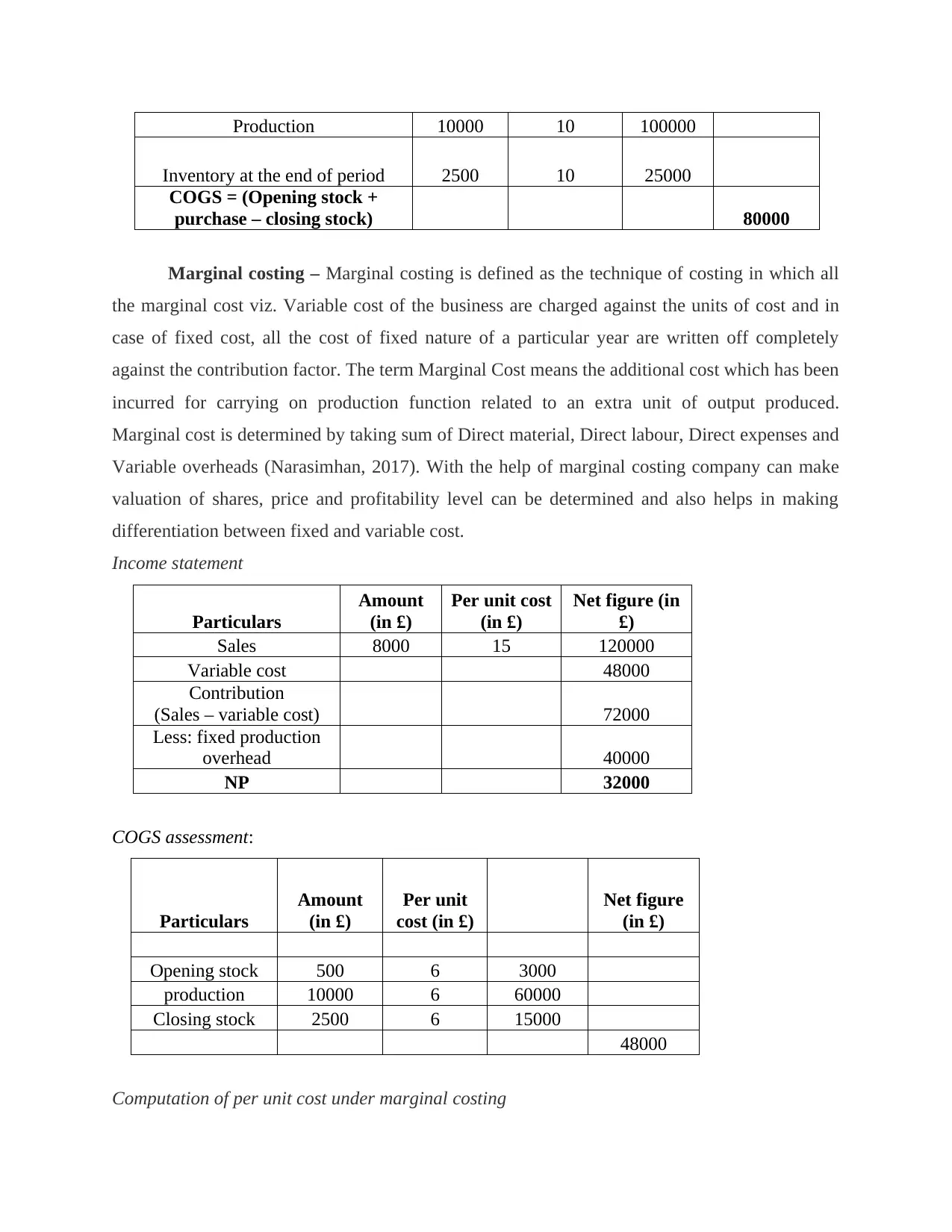
Production 10000 10 100000
Inventory at the end of period 2500 10 25000
COGS = (Opening stock +
purchase – closing stock) 80000
Marginal costing – Marginal costing is defined as the technique of costing in which all
the marginal cost viz. Variable cost of the business are charged against the units of cost and in
case of fixed cost, all the cost of fixed nature of a particular year are written off completely
against the contribution factor. The term Marginal Cost means the additional cost which has been
incurred for carrying on production function related to an extra unit of output produced.
Marginal cost is determined by taking sum of Direct material, Direct labour, Direct expenses and
Variable overheads (Narasimhan, 2017). With the help of marginal costing company can make
valuation of shares, price and profitability level can be determined and also helps in making
differentiation between fixed and variable cost.
Income statement
Particulars
Amount
(in £)
Per unit cost
(in £)
Net figure (in
£)
Sales 8000 15 120000
Variable cost 48000
Contribution
(Sales – variable cost) 72000
Less: fixed production
overhead 40000
NP 32000
COGS assessment:
Particulars
Amount
(in £)
Per unit
cost (in £)
Net figure
(in £)
Opening stock 500 6 3000
production 10000 6 60000
Closing stock 2500 6 15000
48000
Computation of per unit cost under marginal costing
Inventory at the end of period 2500 10 25000
COGS = (Opening stock +
purchase – closing stock) 80000
Marginal costing – Marginal costing is defined as the technique of costing in which all
the marginal cost viz. Variable cost of the business are charged against the units of cost and in
case of fixed cost, all the cost of fixed nature of a particular year are written off completely
against the contribution factor. The term Marginal Cost means the additional cost which has been
incurred for carrying on production function related to an extra unit of output produced.
Marginal cost is determined by taking sum of Direct material, Direct labour, Direct expenses and
Variable overheads (Narasimhan, 2017). With the help of marginal costing company can make
valuation of shares, price and profitability level can be determined and also helps in making
differentiation between fixed and variable cost.
Income statement
Particulars
Amount
(in £)
Per unit cost
(in £)
Net figure (in
£)
Sales 8000 15 120000
Variable cost 48000
Contribution
(Sales – variable cost) 72000
Less: fixed production
overhead 40000
NP 32000
COGS assessment:
Particulars
Amount
(in £)
Per unit
cost (in £)
Net figure
(in £)
Opening stock 500 6 3000
production 10000 6 60000
Closing stock 2500 6 15000
48000
Computation of per unit cost under marginal costing
Paraphrase This Document
Need a fresh take? Get an instant paraphrase of this document with our AI Paraphraser
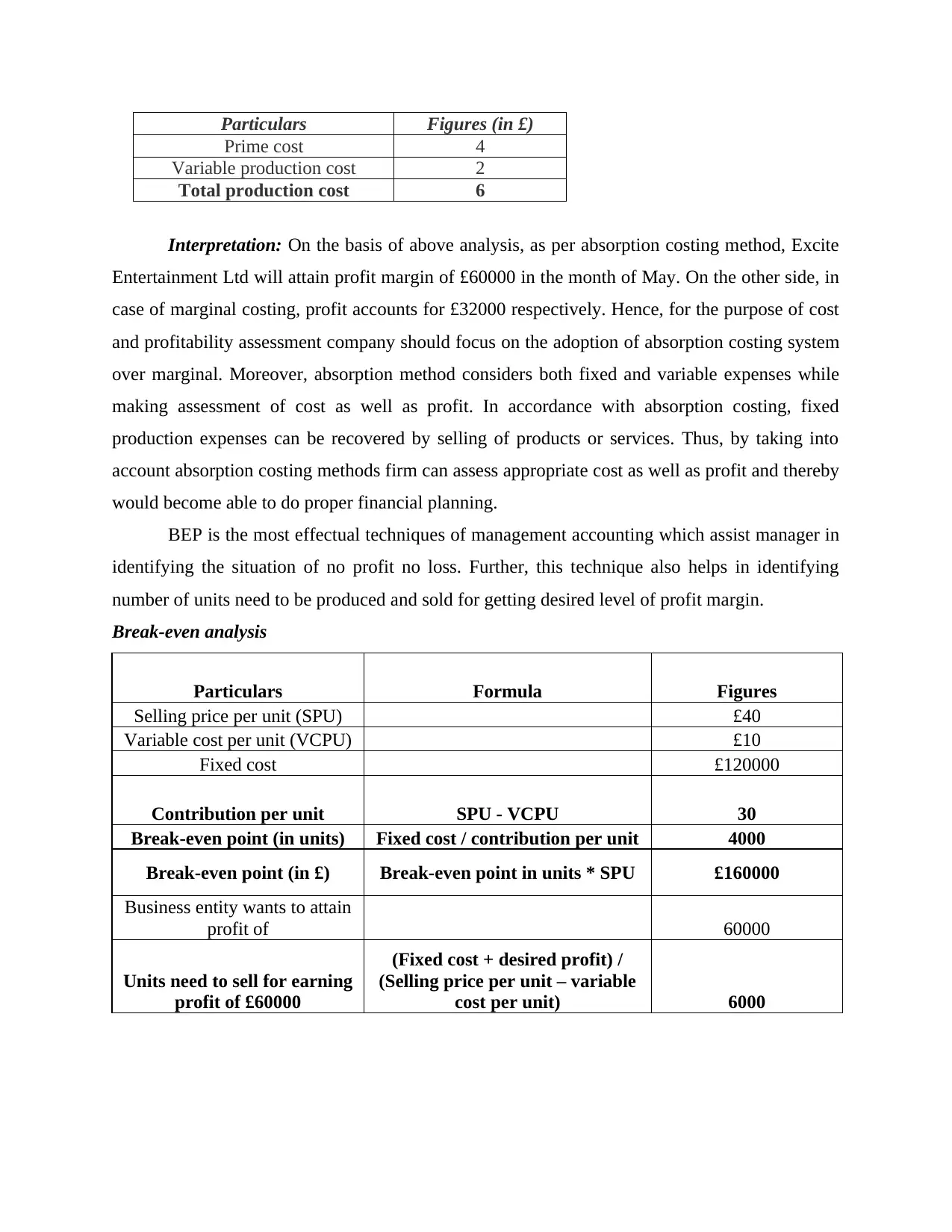
Particulars Figures (in £)
Prime cost 4
Variable production cost 2
Total production cost 6
Interpretation: On the basis of above analysis, as per absorption costing method, Excite
Entertainment Ltd will attain profit margin of £60000 in the month of May. On the other side, in
case of marginal costing, profit accounts for £32000 respectively. Hence, for the purpose of cost
and profitability assessment company should focus on the adoption of absorption costing system
over marginal. Moreover, absorption method considers both fixed and variable expenses while
making assessment of cost as well as profit. In accordance with absorption costing, fixed
production expenses can be recovered by selling of products or services. Thus, by taking into
account absorption costing methods firm can assess appropriate cost as well as profit and thereby
would become able to do proper financial planning.
BEP is the most effectual techniques of management accounting which assist manager in
identifying the situation of no profit no loss. Further, this technique also helps in identifying
number of units need to be produced and sold for getting desired level of profit margin.
Break-even analysis
Particulars Formula Figures
Selling price per unit (SPU) £40
Variable cost per unit (VCPU) £10
Fixed cost £120000
Contribution per unit SPU - VCPU 30
Break-even point (in units) Fixed cost / contribution per unit 4000
Break-even point (in £) Break-even point in units * SPU £160000
Business entity wants to attain
profit of 60000
Units need to sell for earning
profit of £60000
(Fixed cost + desired profit) /
(Selling price per unit – variable
cost per unit) 6000
Prime cost 4
Variable production cost 2
Total production cost 6
Interpretation: On the basis of above analysis, as per absorption costing method, Excite
Entertainment Ltd will attain profit margin of £60000 in the month of May. On the other side, in
case of marginal costing, profit accounts for £32000 respectively. Hence, for the purpose of cost
and profitability assessment company should focus on the adoption of absorption costing system
over marginal. Moreover, absorption method considers both fixed and variable expenses while
making assessment of cost as well as profit. In accordance with absorption costing, fixed
production expenses can be recovered by selling of products or services. Thus, by taking into
account absorption costing methods firm can assess appropriate cost as well as profit and thereby
would become able to do proper financial planning.
BEP is the most effectual techniques of management accounting which assist manager in
identifying the situation of no profit no loss. Further, this technique also helps in identifying
number of units need to be produced and sold for getting desired level of profit margin.
Break-even analysis
Particulars Formula Figures
Selling price per unit (SPU) £40
Variable cost per unit (VCPU) £10
Fixed cost £120000
Contribution per unit SPU - VCPU 30
Break-even point (in units) Fixed cost / contribution per unit 4000
Break-even point (in £) Break-even point in units * SPU £160000
Business entity wants to attain
profit of 60000
Units need to sell for earning
profit of £60000
(Fixed cost + desired profit) /
(Selling price per unit – variable
cost per unit) 6000
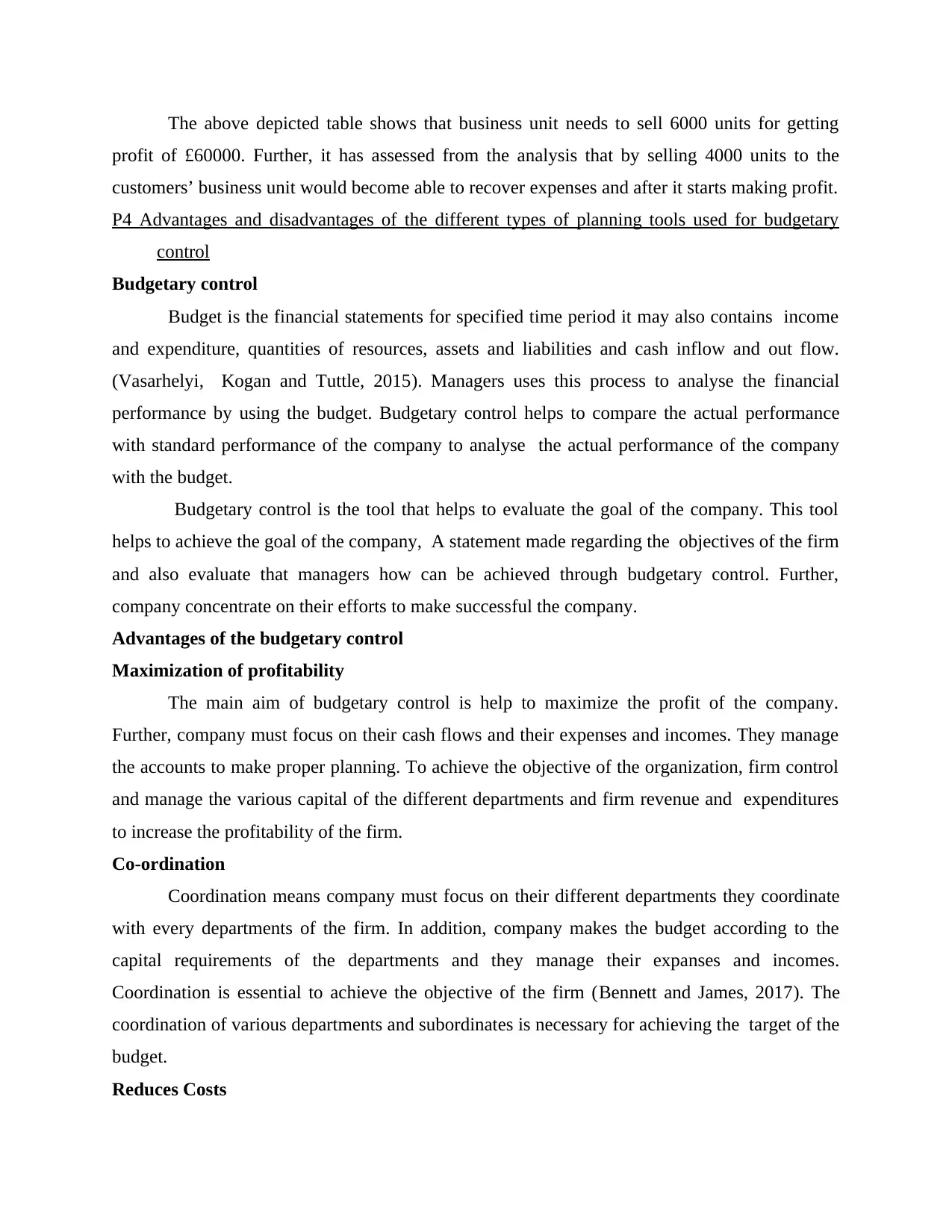
The above depicted table shows that business unit needs to sell 6000 units for getting
profit of £60000. Further, it has assessed from the analysis that by selling 4000 units to the
customers’ business unit would become able to recover expenses and after it starts making profit.
P4 Advantages and disadvantages of the different types of planning tools used for budgetary
control
Budgetary control
Budget is the financial statements for specified time period it may also contains income
and expenditure, quantities of resources, assets and liabilities and cash inflow and out flow.
(Vasarhelyi, Kogan and Tuttle, 2015). Managers uses this process to analyse the financial
performance by using the budget. Budgetary control helps to compare the actual performance
with standard performance of the company to analyse the actual performance of the company
with the budget.
Budgetary control is the tool that helps to evaluate the goal of the company. This tool
helps to achieve the goal of the company, A statement made regarding the objectives of the firm
and also evaluate that managers how can be achieved through budgetary control. Further,
company concentrate on their efforts to make successful the company.
Advantages of the budgetary control
Maximization of profitability
The main aim of budgetary control is help to maximize the profit of the company.
Further, company must focus on their cash flows and their expenses and incomes. They manage
the accounts to make proper planning. To achieve the objective of the organization, firm control
and manage the various capital of the different departments and firm revenue and expenditures
to increase the profitability of the firm.
Co-ordination
Coordination means company must focus on their different departments they coordinate
with every departments of the firm. In addition, company makes the budget according to the
capital requirements of the departments and they manage their expanses and incomes.
Coordination is essential to achieve the objective of the firm (Bennett and James, 2017). The
coordination of various departments and subordinates is necessary for achieving the target of the
budget.
Reduces Costs
profit of £60000. Further, it has assessed from the analysis that by selling 4000 units to the
customers’ business unit would become able to recover expenses and after it starts making profit.
P4 Advantages and disadvantages of the different types of planning tools used for budgetary
control
Budgetary control
Budget is the financial statements for specified time period it may also contains income
and expenditure, quantities of resources, assets and liabilities and cash inflow and out flow.
(Vasarhelyi, Kogan and Tuttle, 2015). Managers uses this process to analyse the financial
performance by using the budget. Budgetary control helps to compare the actual performance
with standard performance of the company to analyse the actual performance of the company
with the budget.
Budgetary control is the tool that helps to evaluate the goal of the company. This tool
helps to achieve the goal of the company, A statement made regarding the objectives of the firm
and also evaluate that managers how can be achieved through budgetary control. Further,
company concentrate on their efforts to make successful the company.
Advantages of the budgetary control
Maximization of profitability
The main aim of budgetary control is help to maximize the profit of the company.
Further, company must focus on their cash flows and their expenses and incomes. They manage
the accounts to make proper planning. To achieve the objective of the organization, firm control
and manage the various capital of the different departments and firm revenue and expenditures
to increase the profitability of the firm.
Co-ordination
Coordination means company must focus on their different departments they coordinate
with every departments of the firm. In addition, company makes the budget according to the
capital requirements of the departments and they manage their expanses and incomes.
Coordination is essential to achieve the objective of the firm (Bennett and James, 2017). The
coordination of various departments and subordinates is necessary for achieving the target of the
budget.
Reduces Costs
⊘ This is a preview!⊘
Do you want full access?
Subscribe today to unlock all pages.

Trusted by 1+ million students worldwide
1 out of 18
Related Documents
Your All-in-One AI-Powered Toolkit for Academic Success.
+13062052269
info@desklib.com
Available 24*7 on WhatsApp / Email
![[object Object]](/_next/static/media/star-bottom.7253800d.svg)
Unlock your academic potential
Copyright © 2020–2025 A2Z Services. All Rights Reserved. Developed and managed by ZUCOL.





